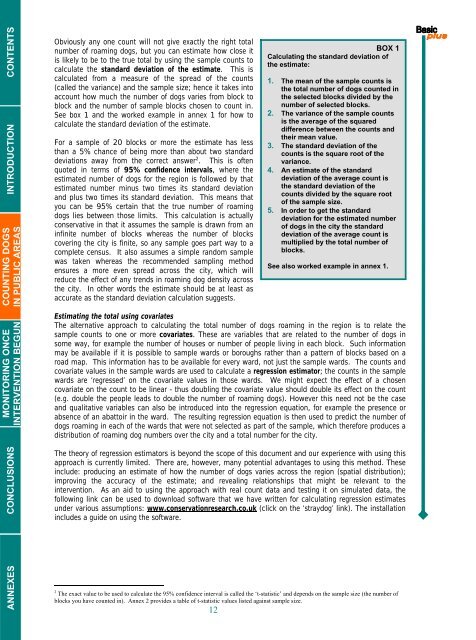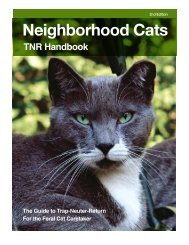Surveying roaming dog populations: guidelines ... - Animal Sheltering
Surveying roaming dog populations: guidelines ... - Animal Sheltering
Surveying roaming dog populations: guidelines ... - Animal Sheltering
Create successful ePaper yourself
Turn your PDF publications into a flip-book with our unique Google optimized e-Paper software.
CONTENTS<br />
INTRODUCTION<br />
COUNTING DOGS<br />
IN PUBLIC AREAS<br />
Obviously any one count will not give exactly the right total<br />
number of <strong>roaming</strong> <strong>dog</strong>s, but you can estimate how close it<br />
is likely to be to the true total by using the sample counts to<br />
calculate the standard deviation of the estimate. This is<br />
calculated from a measure of the spread of the counts<br />
(called the variance) and the sample size; hence it takes into<br />
account how much the number of <strong>dog</strong>s varies from block to<br />
block and the number of sample blocks chosen to count in.<br />
See box 1 and the worked example in annex 1 for how to<br />
calculate the standard deviation of the estimate.<br />
For a sample of 20 blocks or more the estimate has less<br />
than a 5% chance of being more than about two standard<br />
deviations away from the correct answer 2 . This is often<br />
quoted in terms of 95% confidence intervals, where the<br />
estimated number of <strong>dog</strong>s for the region is followed by that<br />
estimated number minus two times its standard deviation<br />
and plus two times its standard deviation. This means that<br />
you can be 95% certain that the true number of <strong>roaming</strong><br />
<strong>dog</strong>s lies between those limits. This calculation is actually<br />
conservative in that it assumes the sample is drawn from an<br />
infinite number of blocks whereas the number of blocks<br />
covering the city is finite, so any sample goes part way to a<br />
complete census. It also assumes a simple random sample<br />
was taken whereas the recommended sampling method<br />
ensures a more even spread across the city, which will<br />
reduce the effect of any trends in <strong>roaming</strong> <strong>dog</strong> density across<br />
the city. In other words the estimate should be at least as<br />
accurate as the standard deviation calculation suggests.<br />
BOX 1<br />
Calculating the standard deviation of<br />
the estimate:<br />
1. The mean of the sample counts is<br />
the total number of <strong>dog</strong>s counted in<br />
the selected blocks divided by the<br />
number of selected blocks.<br />
2. The variance of the sample counts<br />
is the average of the squared<br />
difference between the counts and<br />
their mean value.<br />
3. The standard deviation of the<br />
counts is the square root of the<br />
variance.<br />
4. An estimate of the standard<br />
deviation of the average count is<br />
the standard deviation of the<br />
counts divided by the square root<br />
of the sample size.<br />
5. In order to get the standard<br />
deviation for the estimated number<br />
of <strong>dog</strong>s in the city the standard<br />
deviation of the average count is<br />
multiplied by the total number of<br />
blocks.<br />
See also worked example in annex 1.<br />
MONITORING ONCE<br />
INTERVENTION BEGUN<br />
CONCLUSIONS<br />
Estimating the total using covariates<br />
The alternative approach to calculating the total number of <strong>dog</strong>s <strong>roaming</strong> in the region is to relate the<br />
sample counts to one or more covariates. These are variables that are related to the number of <strong>dog</strong>s in<br />
some way, for example the number of houses or number of people living in each block. Such information<br />
may be available if it is possible to sample wards or boroughs rather than a pattern of blocks based on a<br />
road map. This information has to be available for every ward, not just the sample wards. The counts and<br />
covariate values in the sample wards are used to calculate a regression estimator; the counts in the sample<br />
wards are ‘regressed’ on the covariate values in those wards. We might expect the effect of a chosen<br />
covariate on the count to be linear - thus doubling the covariate value should double its effect on the count<br />
(e.g. double the people leads to double the number of <strong>roaming</strong> <strong>dog</strong>s). However this need not be the case<br />
and qualitative variables can also be introduced into the regression equation, for example the presence or<br />
absence of an abattoir in the ward. The resulting regression equation is then used to predict the number of<br />
<strong>dog</strong>s <strong>roaming</strong> in each of the wards that were not selected as part of the sample, which therefore produces a<br />
distribution of <strong>roaming</strong> <strong>dog</strong> numbers over the city and a total number for the city.<br />
The theory of regression estimators is beyond the scope of this document and our experience with using this<br />
approach is currently limited. There are, however, many potential advantages to using this method. These<br />
include: producing an estimate of how the number of <strong>dog</strong>s varies across the region (spatial distribution);<br />
improving the accuracy of the estimate; and revealing relationships that might be relevant to the<br />
intervention. As an aid to using the approach with real count data and testing it on simulated data, the<br />
following link can be used to download software that we have written for calculating regression estimates<br />
under various assumptions: www.conservationresearch.co.uk (click on the ‘stray<strong>dog</strong>’ link). The installation<br />
includes a guide on using the software.<br />
ANNEXES<br />
2 The exact value to be used to calculate the 95% confidence interval is called the ‘t-statistic’ and depends on the sample size (the number of<br />
blocks you have counted in). Annex 2 provides a table of t-statistic values listed against sample size.<br />
12








